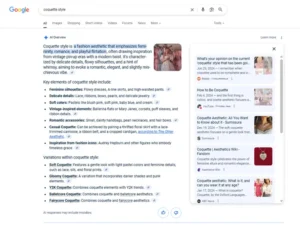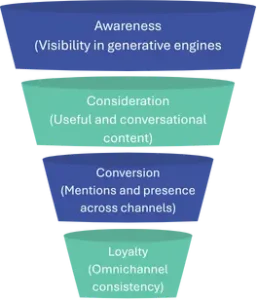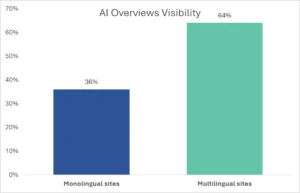Digital marketing never stops, and the rules of search engine optimization are evolving rapidly. What worked yesterday to rank at the top of Google results is no longer enough today. The rise of artificial intelligence in search engines has created a new landscape: GEO for content marketing.
In this article, we’ll explain why Generative Engine Optimization (GEO) is essential for the future of online visibility, outline the best practices you should apply to your content strategy, and highlight how the language of your website can make a real difference.
Generative search is revolutionizing marketing
For over two decades, SEO has formed the backbone of every digital strategy. Positioning an e-commerce site or a brand on Google relied on keywords, backlinks, and proper technical structure. However, the emergence of generative engines has transformed how search and discovery work.
| Aspect | Traditional SEO | GEO (Generative Engine Optimization) |
| Keywords | Exact keyword relevance | Conversational questions and search intent |
| Links | Backlinks as a key factor | Mentions in trusted contexts |
| Content | Optimized for search engines | Optimized for humans and AI engines |
| Platforms | Mainly Google | Multichannel: Google, TikTok, ChatGPT, Perplexity, Amazon |
| Metrics | CTR, sessions, bounce rate | Presence in AI results, brand visibility |
| Languages | Basic translations | Multilingual localization and cultural adaptation |
The distinction is clear: while traditional SEO focused on the algorithm, GEO focuses on how AI understands, interprets, and recommends content. Optimizing for exact keywords or backlinks alone is no longer enough. What truly drives visibility today is how your brand appears in AI-generated summaries.
A clear example is Google’s AI Overviews, which provide complete answers at the top of the results page and increasingly push traditional organic links further down. Being present in these opening paragraphs is equivalent to occupying the best storefront on the busiest street, and this is where GEO becomes a decisive factor.
Indeed, content optimized for generative engines can increase conversion rates by up to 20%, demonstrating that GEO is not just a trend, but a tangible competitive advantage for brands looking to grow online.
6 Steps to apply GEO in your content marketing
The good news is that practical methods exist to integrate GEO into your content strategy. At Linguaserve, we’ve identified six key steps for any digital marketing team looking to optimize results.
✅ Use natural, conversational language
Write as people speak and as AI responds: use sentences that flow naturally, real-life examples, and descriptions that directly address common questions.
✅ Provide context with multimedia content
Images, videos, detailed product descriptions, and semantic attributes add depth and meaning, helping AI interpret your content accurately.
✅ Mentions matter more than links
Mentions in forums, marketplaces, or specialized blogs carry more weight than traditional backlinks, signaling trust and relevance to generative engines.
✅ Multichannel presence is essential
If your brand isn’t active across multiple channels, TikTok, Instagram, YouTube, e-commerce platforms, and forums, AI will find it harder to recommend your content.
✅ Different strategies for desktop and mobile
Tailor your approach: desktop focuses on branding, while mobile emphasizes traffic, engagement, and conversions.
✅ Shift your KPIs: from clicks to presence
Success is no longer measured solely in clicks. Appearing consistently in AI-generated responses has become a critical metric of visibility and influence.
Common e-commerce mistakes to avoid in GEO
Following best practices is crucial, but understanding the pitfalls that can undermine your GEO strategy for content marketing is equally important. The most frequent mistakes in e-commerce include:
- Weak or repetitive content: AI deprioritizes pages that lack depth, context, or language focused on search intent.
- One-size-fits-all strategy: reusing keywords and structures without cultural adaptation reduces visibility and user engagement.
- Literal translation instead of localization: not every party dress translates directly as vestido de fiesta. Search results depend on cultural context and user behavior in each market.
- Ignoring new search platforms: TikTok, ChatGPT, and voice assistants all influence product discovery. Not being present on these platforms is equivalent to not existing.
- Lack of technical structure: without metadata, clear headings, or schema markup, generative engines cannot interpret, prioritize, or display your content correctly.
Recognizing these errors allows you not only to avoid them, but also to reinforce the six GEO best practices with a stronger, future-ready content strategy.
Why translation enhances AI visibility
A common misconception is that translating a website into English alone is sufficient to attract international traffic. In reality, AI prioritizes content in the exact language in which users search.
Recent studies show that multilingual websites achieve significantly higher visibility in AI results compared to monolingual sites. This is because translated, localized, and culturally relevant mentions appear more frequently in generative engine summaries.
When AI prioritizes mentions, placing them prominently in the opening paragraphs, translated content can reach 67% prevalence compared to 33% for untranslated content.
The difference becomes even more pronounced when AI hallucinates. In these cases, the visibility of translated content rises to 83%, while untranslated content only reaches 17%.
This makes localization and professional language management decisive levers for any GEO for content marketing strategy.
The transition from SEO to GEO is not a trend, it is a necessary adaptation to user behavior and the evolution of search technologies. To ensure your brand is visible in generative engines, you must:
- Understand how AI interprets and recommends content.
- Optimize your strategy using GEO best practices.
- Invest in multilingual localization to increase visibility in international markets.
Generative Engine Optimization complements and amplifies traditional SEO. Brands that successfully integrate GEO into their content strategies will lead in the searches of the future.
At Linguaserve, we help companies across industries take this step successfully, combining digital marketing expertise with professional localization. If you want to learn how to apply these practices to your e-commerce site, contact us, and we’ll show you exactly how.





